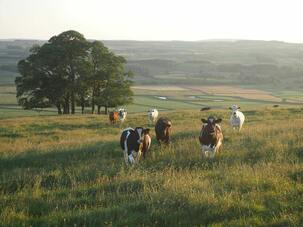 By Donna K. Kelly, Integrative Nutrition Health Coach Concentrated Animal Feed Operations (CAFO) is an industrial agricultural system for raising livestock that started in the 1970s. CAFOs place thousands of animals in a confined area, with large feedlots for cattle, large houses for poultry and pork, and confined netted enclosures for fish. CAFOs pose several threats to you directly and the environment. Let’s start with beef. In large-scale beef production, the cattle are fed corn and soy, which is an unnatural diet for them. Cattle should be grazing on grass in pastures. Corn is omega-6 (inflammatory) and grass is omega-3 (anti-inflammatory). Grass-fed and finished beef is healthier for you and more humane for the animal. Cows are also given bovine growth hormone to add weight quickly in order to get to market more quickly. A shorter time from birth to slaughter means more money. You probably don’t need a dose of bovine growth hormone to help you bulk up. These same types of scenarios can be seen with pigs, chickens, and fish. We would like the animals we raise to live a natural and healthy life eating what nature intended. Antibiotic used in livestock accounts for 80% of antibiotic use in the U.S. An animal raised in a CAFO needs antibiotics in order to stay alive in this unhealthy environment. Antibiotics used in this way support the emergence of superbugs. Superbugs may be antibiotic resistant. You may have heard of the growing concern in medicine over drug resistant bacterial infections. The medical community fears we may one day soon have many drug resistant infections with no antibiotic solutions. This scenario would take our world back to days before antibiotics, like penicillin. Sweden became concerned about the increase in drug resistant pneumonia infections in the 1990s. To counter this increase, they severely restricted antibiotic use in their animal husbandry practices. By also using antibiotics only for bacterial infections in humans, the Swedes saw that antibiotics used for people drop by 43% - 74%, depending on the age of the population being studied. Would you like to live where infections were down? The animal urine and feces generated by the animals in CAFOs is placed in liquid manure lagoons, which may leak into underground water, polluting drinking supplies and the natural ecosystem. CAFOs also account for 18% of human greenhouse gas production. Greenhouse gas helps to fuel climate change that makes it harder for all the animals, plants and humans to thrive, and some even to survive. We depend on the diversity of our home, Earth, for our health and lives.  By Donna K. Kelly Wednesday, April 22nd, is Earth Day, and 2020 is the 50th anniversary. We have made some progress in saving the Earth, our home. But there is much room for improvement. Did you know that your food choices are a powerful way to help the planet sustain us? To eliminate greenhouse gases would be a giant step forward, but what about removing CO2 from the atmosphere? There is a movement working on removing CO2 and it is called Project Drawdown. Food touches everything about our world. Food influences our environment. Local, sustainably-raised food requires healthy soils. Sustainably raised produce uses less, or best, no pesticides or herbicides. This may allow the workers in the fields to experience less disease due to lower exposure to these harsh chemicals. Court cases are now being won by farm workers harmed by pesticide exposure. Food produced with pesticides and herbicides may negatively impact bees, insects, and the microbial diversity of the soils, as well as wildlife and ourselves. Sustainably grown produce may be more nutritious because the produce has less pesticide residue. In addition, the soils are healthier because of the lower pesticide use. Locally grown, sustainably raised produce helps your community. Nearby farms can sustain themselves financially while providing fresher foods. Fresher equals more nutritious food since it may be consumed closer to the time it was picked. Locally grown means less transportation cost in getting your food to you. Victory Gardens planted during World War II made up 40% of our food needs. Victory Gardens were instituted not only to help feed people, but also to free up transportation and labor for the war effort. We could learn from those times and reap the benefits of fresher, nutritious food grown closer to home. This may be important as we learn supply chains can be disrupted. COVID-19 gave us the opportunity to appreciate how we can help to make ourselves more resilient going forward. Our bodies need the most nutritious food we can give them. All the building blocks of optimal nutrition need to be present to give us the best possible health. Food can indeed be our most powerful medicine. To celebrate the anniversary of Earth Day, the April 2020 issue of National Geographic highlights How We Lost the Planet and How We Saved the World. Education is a wonderful way to give ourselves the insight we need to help the earth and ourselves. |
radiate wellnessWe are a community of holistic and alternative healers and counselors dedicated to helping clients achieve spiritual, energetic, and physical well-being. archives
January 2023
categories
All
|
b l o g
/bläɡ/
noun: a regularly updated website or web page, typically one run by an individual or small group, that is written in an informal or conversational style.
©Radiate Wellness, LLC | All Rights Reserved


 RSS Feed
RSS Feed